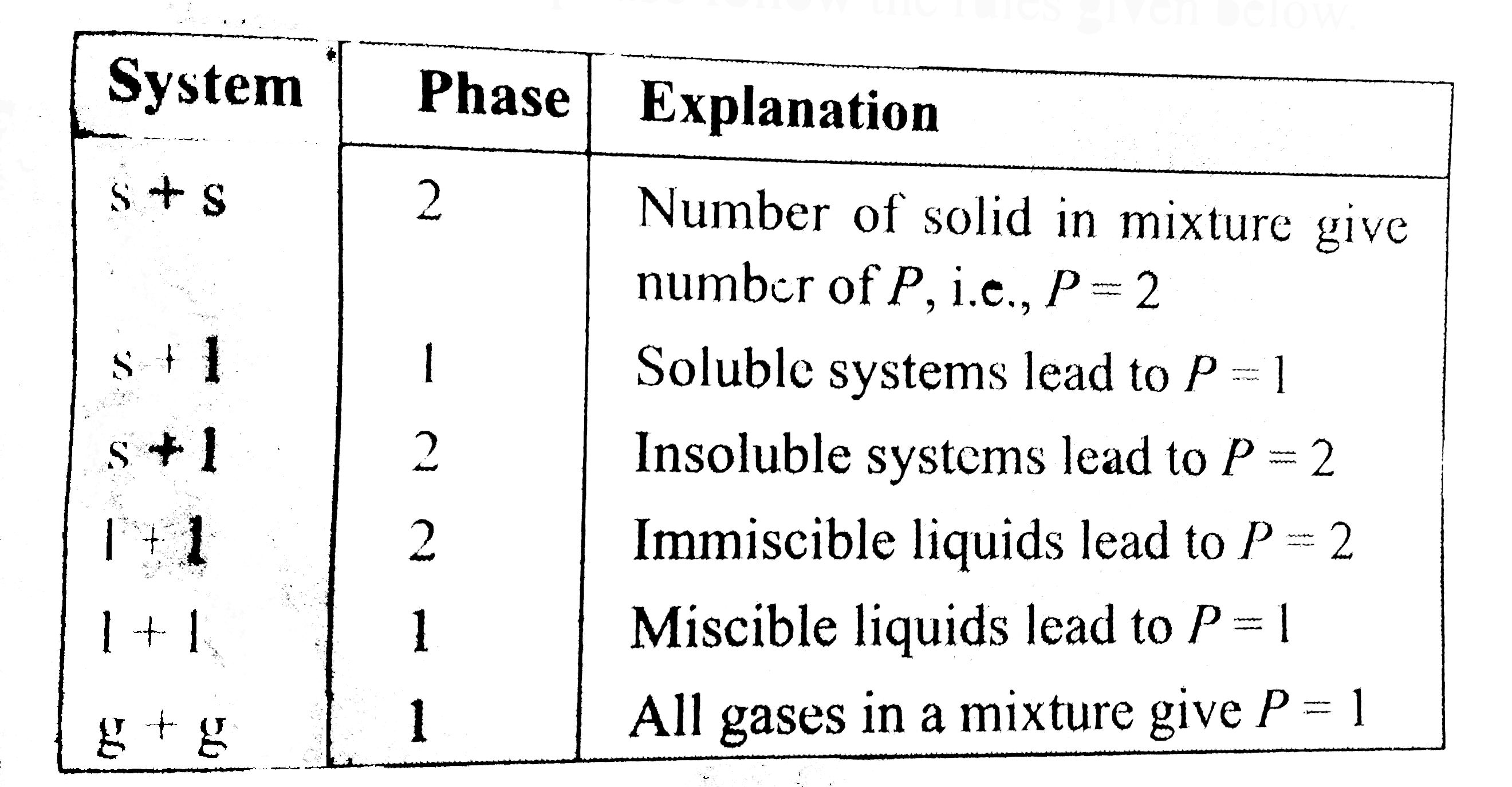State which one is homogeneous or heterogeneous?
a. SRhombus⇔SMonoclinic
b. H2O(l)⇔H2O(g)
c. H2O(s)⇔H2O(l)
d. CDiamond⇔CAmorphous
e. N2(g)+3H2(g)⇔2NH3(g)
f. CuSO4(s)+3NH3(g)⇔CuSO4.3NH3(l)
g. CaCO3(s)⇔CaO(s)+CO2(g)
(1) A system is said to be homogeneous if phase (P)=1 . A system with P≥2 is heterogeneous.
(2) To determine phase follow the rules given below.

Given systemabcdefgNumber of phase2222123
Homogeneous system are: e,
Heter ogenous system are: a,b,c,d,f,g
Topper's Solved these Questions
- BOOK - CENGAGE CHEMISTRYCHAPTER - CHEMICAL EQUILIBRIUMEXERCISE - Concept Applicationexercise 7.153videos
CHEMICAL EQUILIBRIUM
- BOOK - CENGAGE CHEMISTRYCHAPTER - CHEMICAL EQUILIBRIUMEXERCISE - Ex 7.240videos
CHEMICAL EQUILIBRIUM
- BOOK - CENGAGE CHEMISTRYCHAPTER - CHEMICAL BONDING AND MOLECULAR STRUCTUREEXERCISE - Archives Subjective15videos
CHEMICAL BONDING AND MOLECULAR STRUCTURE
- BOOK - CENGAGE CHEMISTRYCHAPTER - CLASSIFICATION AND NOMENCLATURE OF ORGANIC COMPOUNDSEXERCISE - Analytical and Descriptive Type3videos
CLASSIFICATION AND NOMENCLATURE OF ORGANIC COMPOUNDS
Similar Questions
For the reaction, N2(g)+3H2(g)⇔2NH3(g), the units of Kp are …………
View Solutionwhich of the following reactions will get affected by increase in pressure ? Also mention whether the change will cause the reaction to go the right or left direction.
(i) CH4(g)+2S)2(g)⇔CS2(g)+2H2S(g)
(ii) CO2(g)+C(s)⇔2CO(g)
(iii) 4NH3(g)+5O2(g)⇔4NO(g)+6H2O(g)
(iv) C2H4(g)+H2(g)⇔C2H6(g)
(v) COCI2(g)⇔CO(g)+CI2(g)
(vi) CaCO3(g)⇔CaO(s)+CO2(g)View Solution
Knowledge Check
- Question 1 - Select One
For the reaction :
CaCO3(s)⇔CaO(s)+CO2(g)AKp=p(CaCO3)BKp=p(CO2)CKp=1p(CaCO3)DKp=1p(CO2) - Question 2 - Select One
For the reaction
N2(g)+3H2(g)⇔2NH3(g),ΔH=?AΔE+2RTBΔE−2RTCΔE+RTDΔE−RT - Question 3 - Select One
Which of the following is correct for the reaction?
N2(g)+3H2(g)⇔2NH3(g)AKp=KcBKp<KcCKp>KcDPressure is required to predict the correlation
Which of the following reactions will get affected by increasing the pressure? Also, mention whether change will cause the reaction the reaction to go into forward of backward direction.
a. COCl2(g)⇔CO(g)+Cl2(g)
b. CH4(g)+2S2(g)⇔CS2(g)+2H2S(g)
c. CO2(g)+C(s)⇔2CO(g)
d. 2H2(g)+CO(g)⇔CH3OH(g)
e. CaCO3(s)⇔CaO(s)+CO2(g)
f. 4NH3(g)+5O2(g)⇔4NO(g)+6H2O(g)View SolutionHow many of the following reactions are homogenous reversible reactions?
(1) CH3COOH(l)+C2H5OH(l)⇔CH3COOC2H5(l)+H2O(l)
(2) C(s)+CO2(g)⇔CO(g)+H2O(g)
(3) H2(g)+CO2(g)⇔CO(g)+H2O(g)
(4) CO(g)+CI2(g)⇔COCI2(g)
(5) NH4HSs⇔NH3(g)+H2S(g)
(6) CaCO3(s)⇔CaO(s)+CO2(s)
(7) N2(g)O2(g)⇔2NO(g)
(8) CO2(g)+C(s)⇔2CO(g)
(9) SO2+NO2(g)⇔SO3(g)+NO(g)
(10) NO(g)+12Br2(l)⇔2NOBr(g)View SolutionWhich of the following is correct for the reaction?
N2(g)+3H2(g)⇔2NH3(g)View SolutionKC for the reaction 12N2(g)+32H2(g)⇔NH3(g) is
View SolutionWhich of the following is correct for the reaction?
N2(g)+3H2(g)⇔2NH3(g)View Solution

